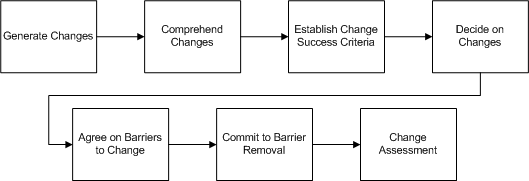Develop Changes
Description
|
The Develop Change area of problem solving is initiated by the stackholders determining what needs to be done and how it can be done with respect to the problem. Important aspects including: how success will be measured, the best combination of changes, and the potential obstacles and their corresponding aversion options will be resolved in order to ensure the highest rate of success for implementing the chosen change option. In conclusion, a final change assessment will be made by the stakeholders, answering the question “What needs to be changed?” with respect to the problem trying to be solved. Process Flow Diagram
Procedures |
Purpose
The goal!
To Generate Changes, identifying ways to handle and resolve each problem and its causes, as well as cross-problem causes and root causes.
Why do it?
Without Generating Changes for problems and causes from each stakeholder’s perspective, there is little likelihood of developing commitment, while ensuring resolution and ongoing improvement.
What to do:
With your Problem Solving document open to Generate Changes, ask the stakeholders the question “What needs to be done?” with respect to the problem you are trying to solve.
Decision:
Has enough information been generated to move forward?
Responsibility
Team Leader
Procedure
Follow these steps to initialize change generation:
Step
Action
1
Press ALT + TAB to the Problem Solving document.
Result: You move between your browser and the framing document.
2
Scroll to the Generate Changes frame.
3
Type a list of changes either by sharing (presenting or reviewing) and ⁄ or creating (brainstorming or expanding) ideas about what needs to be done.
4
Label changes as temporary fixes, solutions, principles, or mindsets, along with who is impacted.
Example

Tools
FrameTEC-MS Word
Purpose
The goal!
To Comprehend Changes in order to define how to resolve the problems and their causes.
Why do it?
To develop implementable changes that achieve the Desired Results.
To focus on what to improve.
To focus on how to improve over time and in what combination these improvements can ensure results.
What to do:
With your Problem Solving document open to Comprehend Changes, ask the stakeholders the question “How can we do it?” with respect to the problem you are trying to solve.
Decision:
Has enough information been generated to move forward?
Responsibility
Team Leader
Procedure
Follow these steps to comprehend changes:
Step
Action
1
Press ALT + TAB to the Problem Solving document.
Result: You move between your browser and the framing document.
2
Scroll to the Comprehend Changes frame.
3
Retype changes by refining “what needs to be done?” into “how we can do it?”
4
Deepen understanding by typing assumptions, sequence, and interrelationship of changes.
Example

Tools
FrameTEC-MS Word
Purpose
The goal!
To Establish Success Criteria that clarifies and prioritizes the Desired Results as gauges for assessing potential for Change options.
Why do it?
Valuing Success Criteria focuses team work for judging worthwhile progress of the change options. This ensures a viable basis for evaluating the potential success of the various changes and combinations of changes.
What to do:
With your Problem Solving document open to Establish Change Success Criteria, ask the stakeholders the question “How can we measure our success?” with respect to the problem you are trying to solve.
Decision:
Has enough information been generated to move forward?
Responsibility
Team Leader
Procedure
Follow these steps to establish change success criteria:
Step
Action
1
Press ALT + TAB to the Problem Solving document.
Result: You move between your browser and the framing document.
2
Scroll to Establish Change Success Criteria frame.
3
Adapt the Changes into Options for evaluation.
4
For each Desired Result, type the measurable cost, quality, and time criteria.
5
Then prioritize each desired result for optimum overall improvement.
Example
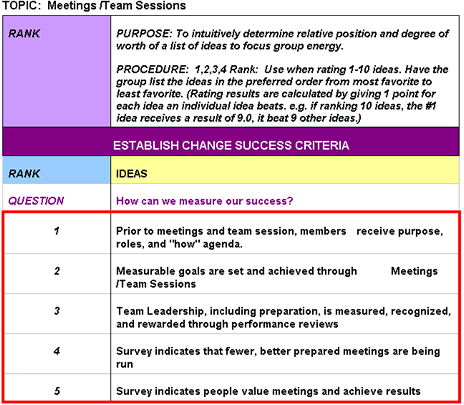
Tools
FrameTEC-MS Word
Purpose
The goal!
To Decide on Changes, applying the Success Criteria to evaluate the Change Options.
Why do it?
To choose the optimum sequence, combination, and timing of changes.
To determine the best Change Options in terms of specific results, timing, and cumulative impact.
What to do:
With your Problem Solving document open to Decide on Changes, ask the stakeholders the question “What is the best combination of changes?” with respect to the problem you are trying to solve.
Decision:
Has enough information been generated to move forward?
Responsibility
Team Leader
Procedure
Follow these steps to initialize change generation:
Step
Action
1
Press ALT + TAB to the Problem Solving document.
Result: You move between your browser and the framing document.
2
Scroll to Decide on Changes frame.
3
Apply each Success Criteria to each Change Option.
4
Try different combinations of changes to better meet the criteria.
5
Look across this evaluation and apply test if anything is missing.
Important: Be sure that the evaluation makes sense.
Example
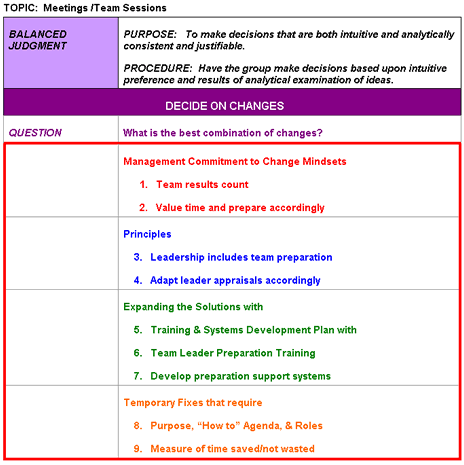
Tools
FrameTEC-MS Work
Purpose
The goal!
To Agree on Barriers to Changes by surfacing, before the fact, the likely obstacles to implementing the chosen change option(s).
Why do it?
Agreeing on Barriers to Changes enables barrier removal and ⁄ or revision of the change option(s) prior to implementation planning.
What to do:
With your Problem Solving document open to Barriers to Change, ask the stakeholders the question “What are the potential obstacles to implementing the chosen change options?” with respect to the problem you are trying to solve.
Decision:
Has enough information been generated to move forward?
Responsibility
Team Leader
Procedure
Follow these steps to gain agreement on barriers to change:
Step
Action
1
Press ALT + TAB to the Problem Solving document.
Result: You move between your browser and the framing document.
2
Scroll to Agree on Barriers to Change frame.
3
Type the potential obstacles as well as their impact to the Chosen Change Option(s).
4
Test if options can be modified, or changes substituted.
5
Note ongoing implications.
Example
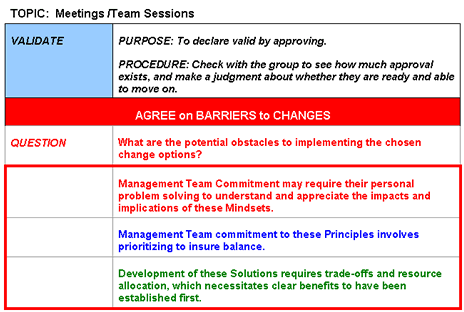
Tools
FrameTEC-MS Word
Purpose
The goal!
To Commit to Barrier Removal, defining the specific actions to overcome the obstacles.
Why do it?
Barrier removal helps to ensure the unobstructed implementation of the chosen change option(s).
Barrier Removal avoids the pitfalls that inevitably disrupt implementation.
What to do:
With your Problem Solving document open to Barrier Removal, ask the stakeholders the question “What are the options for avoiding, averting or removing the obstacles?” with respect to the problem you are trying to solve.
Decision:
Has enough information been generated to move forward?
Responsibility
Team Leader
Procedure
Follow these steps to gain commitment to barrier removal:
Step
Action
1
Press ALT + TAB to the Problem Solving document.
Result: You move between your browser and the framing document.
2
Scroll to Barrier Removal frame.
3
For each Barrier, type an option for how to avoid, avert, or remove the obstacle.
4
Given the implications and impacts of these actions, ensure agreement and organizational commitment to them.
Example
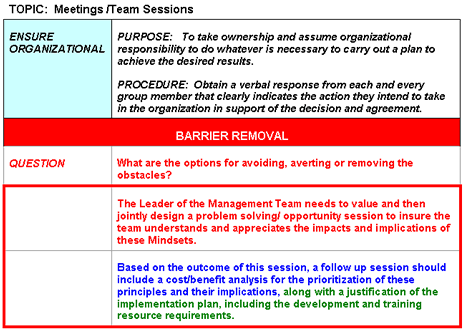
Tools
FrameTEC-MS Word
Purpose
The goal!
Why do it?
What to do:
With your Problem Solving document open to Change Assessment, ask the stakeholders the question “What needs to be changed?” with respect to the problem you are trying to solve.
Decision:
Has enough information been generated to move forward?
Responsibility
Team Leader
Procedure
Follow these steps for change assessment:
Step
Action
1
Press ALT + TAB to the Problem Solving document.
Result: You move between your browser and the framing document.
2
Scroll to Change Assessment frame.
3
For each potential opportunity, type the measurable outcome for success.
4
Retype them as initial criteria for success, noting implications, and confirming agreement and commitment to each.
Example

Tools
FrameTEC-MS Word
